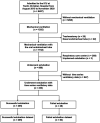Developing a machine-learning model for real-time prediction of successful extubation in mechanically ventilated patients using time-series ventilator-derived parameters
- PMID: 37228399
- PMCID: PMC10203709
- DOI: 10.3389/fmed.2023.1167445
Developing a machine-learning model for real-time prediction of successful extubation in mechanically ventilated patients using time-series ventilator-derived parameters
Abstract
Background: Successful weaning from mechanical ventilation is important for patients admitted to intensive care units. However, models for predicting real-time weaning outcomes remain inadequate. Therefore, this study aimed to develop a machine-learning model for predicting successful extubation only using time-series ventilator-derived parameters with good accuracy.
Methods: Patients with mechanical ventilation admitted to the Yuanlin Christian Hospital in Taiwan between August 2015 and November 2020 were retrospectively included. A dataset with ventilator-derived parameters was obtained before extubation. Recursive feature elimination was applied to select the most important features. Machine-learning models of logistic regression, random forest (RF), and support vector machine were adopted to predict extubation outcomes. In addition, the synthetic minority oversampling technique (SMOTE) was employed to address the data imbalance problem. The area under the receiver operating characteristic (AUC), F1 score, and accuracy, along with the 10-fold cross-validation, were used to evaluate prediction performance.
Results: In this study, 233 patients were included, of whom 28 (12.0%) failed extubation. The six ventilatory variables per 180 s dataset had optimal feature importance. RF exhibited better performance than the others, with an AUC value of 0.976 (95% confidence interval [CI], 0.975-0.976), accuracy of 94.0% (95% CI, 93.8-94.3%), and an F1 score of 95.8% (95% CI, 95.7-96.0%). The difference in performance between the RF and the original and SMOTE datasets was small.
Conclusion: The RF model demonstrated a good performance in predicting successful extubation in mechanically ventilated patients. This algorithm made a precise real-time extubation outcome prediction for patients at different time points.
Keywords: extubation; intensive care unit; machine learning; mechanical ventilation; prediction model.
Copyright © 2023 Huang, Hsu, Chen, Horng, Chung, Lin, Xu and Hou.
Conflict of interest statement
The authors declare that the research was conducted in the absence of any commercial or financial relationships that could be construed as a potential conflict of interest.
Figures
Similar articles
-
Machine Learning for Prediction of Successful Extubation of Mechanical Ventilated Patients in an Intensive Care Unit: A Retrospective Observational Study.J Nippon Med Sch. 2021 Nov 17;88(5):408-417. doi: 10.1272/jnms.JNMS.2021_88-508. Epub 2021 Mar 9. J Nippon Med Sch. 2021. PMID: 33692291
-
Development and Validation of Unplanned Extubation Prediction Models Using Intensive Care Unit Data: Retrospective, Comparative, Machine Learning Study.J Med Internet Res. 2021 Aug 11;23(8):e23508. doi: 10.2196/23508. J Med Internet Res. 2021. PMID: 34382940 Free PMC article.
-
Explainable machine learning approach to predict extubation in critically ill ventilated patients: a retrospective study in central Taiwan.BMC Anesthesiol. 2022 Nov 14;22(1):351. doi: 10.1186/s12871-022-01888-y. BMC Anesthesiol. 2022. PMID: 36376785 Free PMC article.
-
Machine learning for predicting successful extubation in patients receiving mechanical ventilation.Front Med (Lausanne). 2022 Aug 11;9:961252. doi: 10.3389/fmed.2022.961252. eCollection 2022. Front Med (Lausanne). 2022. PMID: 36035403 Free PMC article. Review.
-
Effectiveness of dexmedetomidine versus propofol on extubation times, length of stay and mortality rates in adult cardiac surgery patients: a systematic review and meta-analysis.JBI Database System Rev Implement Rep. 2018 May;16(5):1220-1239. doi: 10.11124/JBISRIR-2017-003488. JBI Database System Rev Implement Rep. 2018. PMID: 29762314
Cited by
-
Post-surgical fall risk prediction: a machine learning approach for spine and lower extremity procedures.Front Med (Lausanne). 2025 Apr 15;12:1574305. doi: 10.3389/fmed.2025.1574305. eCollection 2025. Front Med (Lausanne). 2025. PMID: 40303369 Free PMC article.
-
Automated mechanical ventilator design and analysis using neural network.Sci Rep. 2025 Jan 25;15(1):3212. doi: 10.1038/s41598-025-87946-0. Sci Rep. 2025. PMID: 39863712 Free PMC article.
-
Machine learning for diabetic foot care: accuracy trends and emerging directions in healthcare AI.Front Public Health. 2025 Jul 18;13:1613946. doi: 10.3389/fpubh.2025.1613946. eCollection 2025. Front Public Health. 2025. PMID: 40756392 Free PMC article.
-
Using ML techniques to predict extubation outcomes for patients with central nervous system injuries in the Yun-Gui Plateau.Sci Rep. 2025 May 22;15(1):17773. doi: 10.1038/s41598-025-98861-9. Sci Rep. 2025. PMID: 40404881 Free PMC article.
-
Advances in Machine Learning for Mechanically Ventilated Patients.Int J Gen Med. 2025 Jun 21;18:3301-3311. doi: 10.2147/IJGM.S515170. eCollection 2025. Int J Gen Med. 2025. PMID: 40568522 Free PMC article. Review.
References
LinkOut - more resources
Full Text Sources




